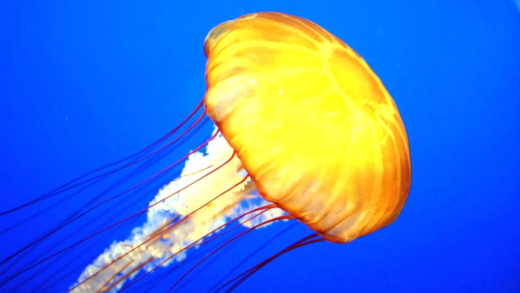Blobfish illustrate how cultural perceptions of beauty can vary widely. The media shapes their image, often highlighting their unusual appearance while neglecting their ecological roles. Understanding blobfish teaches us about adaptation and the importance of marine diversity.
Blobfish in Their Natural Habitat: What Do They Really Look Like?
Blobfish are often misunderstood due to their unusual appearance. In their natural habitat, which is typically deep ocean waters off the coasts of Australia and New Zealand, these fish exhibit a more gelatinous and less grotesque look than when they are brought to the surface. Blobfish thrive at depths between 600 to 1,200 meters, where the pressure is immense and their bodies are adapted to these conditions.
In the depths, blobfish have a structure that allows them to float just above the ocean floor. Their bodies are primarily made of a gelatinous substance that is less dense than water, which helps them conserve energy while drifting. This adaptation is crucial for survival in the deep sea, where food is scarce. They primarily feed on small crustaceans and other organic matter that drifts by.
- Blobfish are not as ugly in their natural environment; they have a more streamlined appearance.
- They rely on their gelatinous bodies to survive the high-pressure conditions of the deep sea.
- Their diet consists mainly of small sea creatures, highlighting their role in the ecosystem.
Understanding the blobfish’s appearance in their natural habitat provides insight into their adaptations and ecological significance. Rather than being merely an “ugly” fish, blobfish are fascinating examples of nature’s ingenuity in extreme environments.
Blobfish and Their ‘Ugly’ Reputation: Why Are They Considered the World’s Ugliest Animal?
The blobfish has earned the title of “world’s ugliest animal” largely due to its appearance when out of its natural habitat. When brought to the surface, the blobfish’s body collapses under the lower pressure, resulting in a droopy, misshapen face. This drastic change contributes to its negative reputation, as many people associate beauty with symmetry and form.
Media portrayals have played a significant role in shaping public perception. The blobfish’s appearance has been sensationalized in various platforms, often depicting it in a comical or grotesque light. This portrayal can lead to misunderstandings about the species, overshadowing its ecological importance.
- Blobfish are often depicted as ugly due to their appearance when out of water.
- The media contributes to their negative image through sensationalized representations.
- This reputation can detract from their ecological significance and adaptability.
Despite the blobfish’s reputation, it serves as a reminder that beauty is subjective and often influenced by environmental contexts. Understanding this can foster a greater appreciation for the diversity of life forms in our oceans.
How the Blobfish Changes Appearance When Brought to the Surface
When blobfish are brought to the surface, they undergo a dramatic transformation that highlights the impact of environmental conditions on their appearance. At depths, their bodies are perfectly adapted to withstand high pressure, making them appear more streamlined and less amorphous. However, once they are exposed to the lower pressure at the surface, their gelatinous bodies lose structure, resulting in a flattened, droopy appearance.
This change serves as an important lesson about the effects of environmental changes on marine life. The blobfish’s unique adaptation illustrates how species evolve to thrive in specific conditions, and how drastic changes can lead to misinterpretations of their natural state.
- Blobfish exhibit a drastic change in appearance when exposed to lower pressure.
- This transformation is a direct result of their gelatinous body structure.
- Understanding these changes helps highlight the adaptability of marine species.
Recognizing how blobfish alter their appearance under different conditions emphasizes the intricate relationship between organisms and their environments, showcasing the beauty of adaptation in the natural world.
Environmental Conditions Affecting Blobfish Appearance: What You Need to Know
Blobfish are significantly influenced by their environmental conditions. Living at depths of 600 to 1,200 meters, these fish thrive under immense pressure. At these depths, their gelatinous bodies allow them to float effortlessly above the ocean floor. However, changes in their environment can drastically alter their appearance. When blobfish are brought to the surface, the pressure drops, causing their bodies to expand and lose their original shape. This transformation results in the droopy, unattractive look that has led to their reputation as “the world’s ugliest animal.”
Several factors affect the blobfish’s appearance, including:
- Pressure Changes: The shift from high to low pressure causes physical changes in blobfish, leading to their distorted look.
- Temperature Variations: Changes in water temperature can also impact their metabolism and overall appearance.
- Food Availability: The blobfish’s diet primarily consists of crustaceans. Fluctuations in food supply can affect their health and appearance.
Understanding these environmental influences is crucial for appreciating how blobfish adapt to their surroundings. Their unique characteristics are not just about aesthetics; they play a vital role in their survival and ecological niche.
Blobfish Adaptation: How Their Looks Help Them Survive in the Deep Sea
The blobfish’s appearance is not just a matter of beauty; it is a sophisticated adaptation to their deep-sea habitat. Their gelatinous bodies are less dense than water, allowing them to conserve energy while hovering just above the ocean floor. This adaptation is essential in an environment where food can be scarce and the pressure is extreme.
Blobfish have developed several survival strategies, including:
- Energy Conservation: Their unique body structure enables them to float effortlessly, reducing the need for constant swimming.
- Camouflage: In their natural habitat, blobfish blend into their surroundings, making it difficult for predators to spot them.
- Efficient Feeding: Their ability to consume small crustaceans and organic matter that drifts by ensures they have a steady food supply.
The blobfish exemplifies how form follows function in nature. Their appearance may be perceived as unattractive, but it is a testament to their remarkable adaptations in the deep sea. Each blobfish is a living example of how species evolve to thrive in specific environments.
Other Animals Considered ‘Ugly’: Who Else Makes the List?
Blobfish aren’t alone in their classification as “ugly” animals. The perception of beauty varies widely across different species and cultures. Other creatures often labeled as unattractive include:
- Axolotl: This amphibian has a peculiar appearance with its external gills and wide head.
- Naked Mole Rat: Known for its wrinkled skin and lack of fur, this rodent is often considered unappealing.
- Vulture: With their bald heads and scruffy feathers, vultures are frequently deemed unattractive.
The perception of animal beauty is subjective and often shaped by cultural norms and media portrayals. While blobfish and other creatures may be labeled “ugly,” they each play essential roles in their ecosystems, reminding us that beauty lies not just in appearance but also in the diversity and complexity of life.
Cultural Perceptions of Animal Beauty: Do They Vary?
Blobfish highlight how cultural perceptions of beauty in animals can differ dramatically across societies. In some cultures, unique features or unconventional appearances might be celebrated, while in others, standard notions of beauty dominate. For instance, in Western societies, the blobfish’s gelatinous and droopy appearance has earned it the title of ‘ugliest animal.’ Yet, in some Asian cultures, different creatures like the axolotl are appreciated for their unusual looks and even considered symbols of good luck.
Factors influencing these perceptions include:
- Media Representation: How animals are portrayed in films, documentaries, and social media can shape public perception significantly.
- Cultural Symbolism: Certain animals may carry specific meanings or symbolism in different cultures, affecting their perceived beauty.
- Personal Experiences: Individual encounters with animals often shape personal views on beauty, making it subjective.
Ultimately, the blobfish serves as a reminder that beauty is not universally defined. This variation in perception enriches our understanding of animal diversity and challenges us to appreciate all forms of life.
The Media’s Role in Shaping the Blobfish’s Image
The media plays a crucial role in shaping the public’s perception of the blobfish. Sensationalized images and headlines often emphasize its ‘ugly’ characteristics, which can overshadow its ecological significance. For example, viral social media posts frequently highlight the blobfish’s droopy face when brought to the surface, reinforcing negative stereotypes.
Key points regarding media influence include:
- Visual Impact: Striking images of the blobfish in its distorted state attract attention, often at the expense of its true nature.
- Misrepresentation: The media often neglects to show the blobfish in its natural habitat, where it appears more streamlined and adapted.
- Public Perception: Repeated exposure to negative portrayals can lead to entrenched views about the blobfish being unattractive.
This media framing can detract from the blobfish’s role in marine ecosystems, emphasizing the need for more balanced representations that highlight the beauty of ocean diversity.
Lessons from the Blobfish: What They Teach Us About Ocean Diversity
Blobfish offer valuable insights into ocean diversity and adaptation. Their unique physiological traits exemplify how species evolve to thrive in specific environments. By examining the blobfish, we learn about the importance of preserving diverse marine habitats.
Lessons include:
- Adaptation: The blobfish’s gelatinous body enables it to survive in high-pressure environments, showcasing the incredible adaptations marine life can develop.
- Ecological Roles: Every species, regardless of appearance, plays a vital role in its ecosystem, contributing to the overall health of marine environments.
- Awareness and Conservation: Understanding the blobfish’s plight can foster greater awareness about ocean health and the need for conservation efforts.
In summary, the blobfish is more than just a quirky example of marine life; it represents the complex web of life in our oceans. By appreciating its unique adaptations, we can advocate for the protection of diverse marine ecosystems that harbor countless other fascinating creatures.





Comments are closed.